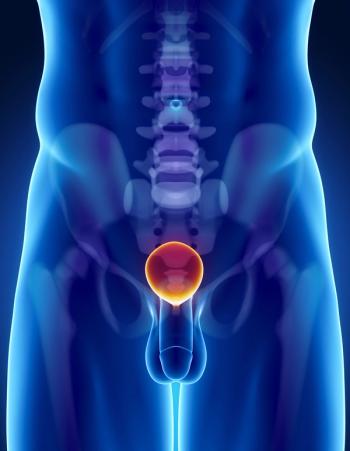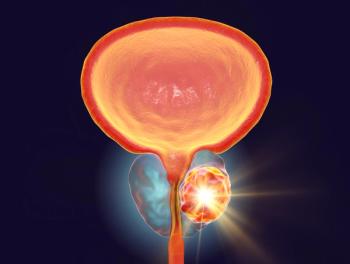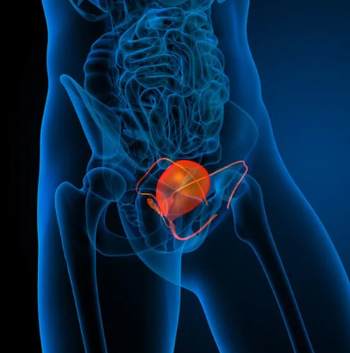
Treating Prostate Cancer
In the November 30, 2007, issue of ONCOLOGY, Dr. Tony S. Quang and colleagues have raised some very important and relevant issues regarding the costs and benefits of new technology in the treatment of prostate cancer ("Technologic Evolution in the Treatment of Prostate Cancer: Clinical, Financial, and Legal Implications for Managed Care Organizations," ONCOLOGY 21[13]:1598-1604, 2007).
In the November 30, 2007, issue of ONCOLOGY, Dr. Tony S. Quang and colleagues have raised some very important and relevant issues regarding the costs and benefits of new technology in the treatment of prostate cancer ("Technologic Evolution in the Treatment of Prostate Cancer: Clinical, Financial, and Legal Implications for Managed Care Organizations," ONCOLOGY 21[13]:1598-1604, 2007). I shall confine my remarks to the benefits of radiation dose escalation and its implications for intensity-modulated radiation therapy, proton radiation therapy, and brachytherapy.
For patients with intermediate- or high-risk prostate cancer, several prospective randomized trials have shown that overall survival improved when androgen deprivation was added to radiation therapy.[1-7] In all those trials, the dose of radiation to the prostate was approximately 70 Gy. Also noteworthy, improvement in survival was observed within a few years after randomization.
In sharp contrast, prospective, randomized trials of radiation dose escalation have consistently shown that patients receiving 75 to 80 Gy (by photons, protons, or both) did not live any longer but suffered worse toxicity than those receiving about 70 Gy.[8-12] The patients in those trials have been followed for 9 to 26 years. The results have also cast serious doubt upon the value of the surrogate endpoint "freedom from biochemical failure" as a predictor of anything clinically meaningful after radiation therapy for prostate cancer. (The adoption of "freedom from biochemical failure" as a surrogate endpoint after radiation therapy was based not upon evidence, but rather, on expert "consensus."[13-15] In other words, it was hypothesized that "freedom from biochemical failure" would predict survival or quality of life after radiotherapy. So far, that hypothesis remains unproven.)
Androgen deprivation is not without side effects.[16] It is indeed a reasonable and testable hypothesis that dose escalation without androgen deprivation would produce survival and quality of life as good as 70 Gy plus androgen deprivation (or that dose escalation plus androgen deprivation would produce better survival than 70 Gy plus androgen deprivation). However, until studies testing these hypotheses are undertaken and reported, there is no justification for dose escalation outside of clinical trials because patients thus treated have not lived longer-and have suffered worse toxicity.
With regard to low-risk prostate cancer, as Quang et al point out, brachytherapy is a very important treatment modality. The relevant literature, however, consists mostly of retrospective, single-institution studies with their obvious shortcomings. A major contribution to this field was the prospective, multi-institutional study, Radiation Therapy Oncology Group (RTOG) 98-05, which established a solid benchmark by showing excellent survival and a low rate of toxicity.[17] Contrary to the assertions of Quang et al, this study did not find any correlation between implant quality (as measured by the dose to 90% of the prostate, or D90) and patient outcome.
Of note, no institution was allowed to enroll more than eight patients in RTOG 98-05, in order to ensure participation by a broad cross-section of institutions with a diversity of "skill levels." Practitioners not participating in clinical trials would be well-advised to follow the guidelines of this study, until such time as results from other prospective, robust studies become available in the future.
Bhadrasain Vikram, MD
Chief, Clinical Radiation
Oncology Branch
National Cancer Institute
Bethesda, Maryland
References
1. Bolla M, Gonzalez D, Warde P, et al: Improved survival in patients with locally advanced prostate cancer treated with radiotherapy and goserelin. N Engl J Med 337:295-300, 1997.
2. Granfors T, Modig H, Damber JE, et al: Combined orchiectomy and external radiotherapy versus radiotherapy alone for nonmetastatic prostate cancer with or without pelvic lymph node involvement: a prospective randomized study. J Urol 159:2030-2034, 1998.
3. Bolla M, Collette L, Blank L, et al: Long-term results with immediate androgen suppression and external irradiation in patients with locally advanced prostate cancer (an EORTC study): A phase III randomised trial. Lancet 360:103-108, 2002.
4. Hanks GE, Pajak TF, Porter A, et al: Phase III trial of long-term adjuvant androgen deprivation after neoadjuvant hormonal cytoreduction and radiotherapy in locally advanced carcinoma of the prostate: The Radiation Therapy Oncology Group Protocol 92-02. J Clin Oncol 21:3972-3978, 2003.
5. D'Amico AV, Manola J, Loffredo M, et al: 6-month androgen suppression plus radiation therapy vs radiation therapy alone for patients with clinically localized prostate cancer: A randomized controlled trial. JAMA 292:821-827, 2004.
6. D'Amico AV, Chen MH, Renshaw AA, et al: Androgen suppression and radiation vs radiation alone for prostate cancer: A randomized trial. JAMA 299:289-295, 2008.
7. Roach M 3rd, Bae K, Speight J, et al: Short-term neoadjuvant androgen deprivation therapy and external-beam radiotherapy for locally advanced prostate cancer: Long-term results of RTOG 8610. J Clin Oncol 26:585-591, 2008.
8. Shipley WU, Verhey LJ, Munzenrider JE, et al: Advanced prostate cancer: The results of a randomized comparative trial of high dose irradiation boosting with conformal protons compared with conventional dose irradiation using photons alone. Int J Radiat Oncol Biol Phys 32:3-10, 1995.
9. Gardner BG, Zietman AL, Shipley WU, et al: Late normal tissue sequelae in the second decade after high dose radiation therapy with combined photons and conformal protons for locally advanced prostate cancer. J Urol 167:123-126, 2002.
10. Pollack A, Zagars GK, Starkschall G, et al: Prostate cancer radiation dose response: Results of the M. D. Anderson phase III randomized trial. Int J Radiat Oncol Biol Phys 53:1097-1105, 2002.
11. Zietman AI, DeSilvio ML, Slater JD, et al: Comparison of conventional-dose vs high-dose conformal radiation therapy in clinically localized adenocarcinoma of the prostate: A randomized controlled trial. JAMA 294:1233-1239, 2005.
12. Kuban DA, Tucker SL, Dong L, et al: Long-term results of the M. D. Anderson randomized dose-escalation trial for prostate cancer. Int J Radiat Oncol Biol Phys 70:67-74, 2008.
13. American Society for Therapeutic Radiology and Oncology Consensus Panel: Consensus statement: Guidelines for PSA following radiation therapy. Int J Radiat Oncol Biol Phys 37:1035-1041, 1997.
14. Roach M 3rd, Hanks G, Thames H Jr, et al: Defining biochemical failure following radiotherapy with or without hormonal therapy in men with clinically localized prostate cancer: Recommendations of the RTOG-ASTRO Phoenix Consensus Conference. Int J Radiat Oncol Biol Phys 65:965-974, 2006.
15. Vikram B: The PSA conundrum. Radiother Oncol 71:1-2, 2004.
16. D'Amico AV, Denham JW, Crook J, et al: Influence of androgen suppression therapy for prostate cancer on the frequency and timing of fatal myocardial infarctions. J Clin Oncol 25:2420-2425, 2007.
17. Lawton CA, DeSilvio M, Lee WR, et al: Results of a phase II trial of transrectal ultrasound-guided permanent radioactive implantation of the prostate for definitive management of localized adenocarcinoma of the prostate (Radiation Therapy Oncology Group 98-05). Int J Radiat Oncol Biol Phys 67:39-47, 2007.
The Authors Respond
Dr. Bhadrasain Vikram has raised a very important point in his commentary regarding dose-escalation studies in the management of early-stage T1/T2 adenocarcinoma of the prostate. He points out that no dose-escalation study has shown any overall survival benefit for patients treated at a higher dose via external-beam radiation therapy; only an improvement in freedom from biochemical failure has been demonstrated. We are in agreement with Dr. Vikram's assessment.
In fact, in our recent publication, we highlighted problems with the prevalent practice of using new and emerging technology such as intensity-modulated radiation therapy (IMRT), image-guided radiotherapy (IGRT), and stereotactic body radiotherapy (SBRT) in the management of adenocarcinoma of the prostate to increase dose and to achieve tighter margins to spare normal tissue. Despite the increase in costs associated with these modalities, investigation has not shown any overall survival benefit or superior toxicity profiles.[1]
As Dr. Vikram pointed out, brachytherapy continues to be an important, cost-effective treatment modality that provides excellent survival with a low rate of toxicity. However, we would argue that there is a demonstrable correlation between implant quality and patient outcome. Although the Radiation Therapy Oncology Group (RTOG) 98-05 trial allowed a broad cross-section of institutions with a diversity of skills, implants at these institutions were highly "selected" in the sense that they were done by experts in the field. Moreover, the protocol only enrolled 101 patients, a sample size too small to allow an in-depth assessment of toxicity.[2] In most series, the most dreaded toxicity is a rectal fistula, which occurs less than 0.5% of the time.[3,4] A sample size of at least 500 to 5,000 allows such a side effect to be seen. In our most recent series at the VA Puget Sound Health Care System, 4 out of 4,500 implants resulted in rectal fistulas.[5] Therefore, while RTOG 98-05 remains a useful study, it cannot be relied upon to define the risks of brachytherapy toxicity.
While we may differ with Dr. Vikram in certain details, we agree with him that the evidence on which we base our prostate treatments is incomplete. Nevertheless, we must use our judgment to deal with large bodies of imperfect data about efficacy, toxicity, cost, and patient preference in order to best serve our professional role.
References:
References
1. Quang TS, Wallner KE, Herstein PR, et al: Technologic evolution in the treatment
of prostate cancer. Clinical, financial, and legal implications for managed care organizations. Oncology (Williston Park) 21:1598-1600, 1602-1594, 2007.
2. Lawton CA, DeSilvio M, Lee WR, et al: Results of a phase II trial of transrectal ultrasound-guided permanent radioactive implantation of the prostate for definitive management of localized adenocarcinoma of the prostate (Radiation Therapy Oncology Group 98-05). Int J Radiat Oncol Biol Phys 67:39-47, 2007.
3. Waterman FM, Dicker AP: Probability of late rectal morbidity in 125I prostate brachytherapy. Int J Radiat Oncol Biol Phys 55:342-353, 2003.
4. Tran A, Wallner K, Merrick G, et al: Rectal fistulas after prostate brachytherapy. Int J Radiat Oncol Biol Phys 63:150-154, 2005.
5. Mayadev J, Wallner K, Merrick G, et al: Prostate brachytherapy-related rectal fistulas: Tracking, analyzing, and preventing a rare complication. Int J Radiat Oncol Biol Phys. In press.schedules for patients with localized prostate cancer. J Clin Oncol 23:6132-6138, 2005.
Newsletter
Stay up to date on recent advances in the multidisciplinary approach to cancer.

















































































